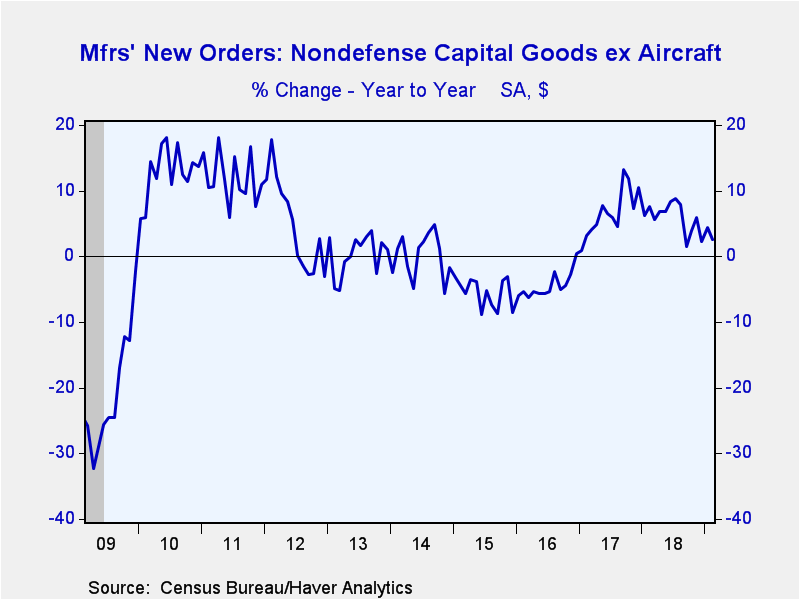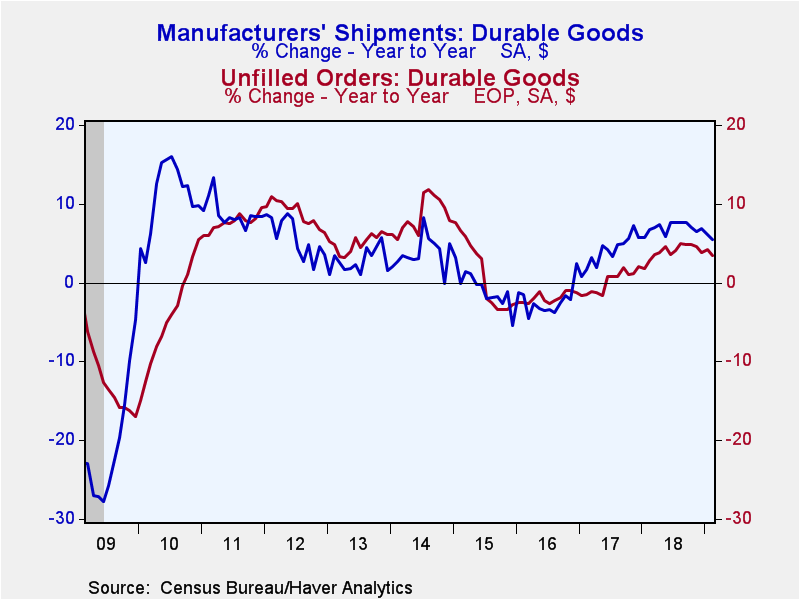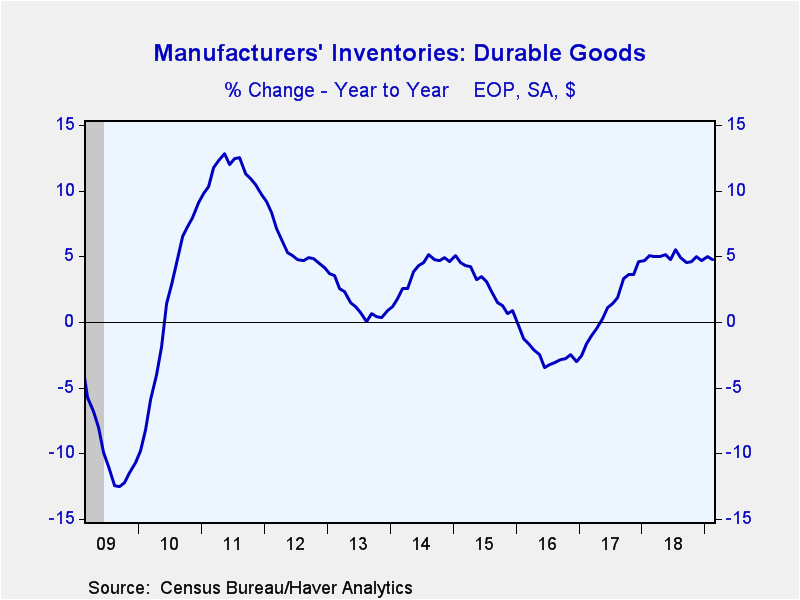 Global| Apr 02 2019
Global| Apr 02 2019U.S. Durable Goods Orders Decline Led by Aircraft
by:Tom Moeller
|in:Economy in Brief
Summary
New orders for durable goods fell 1.6% (+1.8% y/y) during February following a 0.1% January uptick, revised from 0.4%. A 1.0% easing had been expected in the Action Economics Forecast Survey. The decline was led by a 4.8% (-0.8% y/y) [...]
New orders for durable goods fell 1.6% (+1.8% y/y) during February following a 0.1% January uptick, revised from 0.4%. A 1.0% easing had been expected in the Action Economics Forecast Survey. The decline was led by a 4.8% (-0.8% y/y) falloff in transportation sector orders, which were dragged lower by a roughly one-third drop in nondefense aircraft bookings. Orders for defense aircraft rose 2.5% (18.9% y/y). Motor vehicle & parts orders eased 0.1% (+8.4% y/y) following a 0.5% fall.
Nondefense capital goods orders declined 6.3% (-3.8% y/y) after a 1.4% rise. Orders excluding aircraft eased 0.1% (+2.6% y/y) following a 0.9% January gain.
New orders outside of the transportation sector improved 0.1% (3.3% y/y) and reversed the January uptick. Orders for electrical equipment rose 1.0% (4.5% y/y) following a 1.3% gain. Primary metals orders rose 0.7% (5.3% y/y) after a 1.8% decline, and fabricated metal orders nudged 0.3% higher (6.2% y/y) following a 0.4% drop. Working lower by 0.3% (+0.7% y/y) were machinery orders after a 2.0% jump. Orders for computers & electronic product also eased 0.3% (+6.1% y/y), led down by a 1.6% drop (+7.4% y/y) in communications equipment bookings. Orders for computers & related products eased 0.5% (+3.5% y/y), down for the third month in the last four.
Durable product shipments improved 0.2% (5.5% y/y) after a 0.4% decline. Excluding a 0.3% (+8.8% y/y) easing in the transportation sector, durable shipments improved 0.5% (3.9% y/y). Shipments of nondefense capital goods excluding aircraft were fairly steady (3.5% y/y) after a 1.0% jump.
Unfilled durable goods orders declined 0.3% (+3.5% y/y) after rough stability during the prior two months. Backlogs outside of the transportation were unchanged (4.5% y/y) following a 0.1% improvement. Inventories of durable goods rose 0.3% (4.8% y/y) following a 0.5% rise in January. Inventories outside of the transportation sector were fairly steady (5.1% y/y) after moderate m/m increases during the prior two years.
The durable goods figures are available in Haver's USECON database. The Action Economics consensus forecast figure is in the AS1REPNA database
| Durable Goods NAICS Classification | Feb | Jan | Dec | Feb Y/Y | 2018 | 2017 | 2016 |
|---|---|---|---|---|---|---|---|
| New Orders (SA, % chg) | -1.6 | 0.1 | 1.3 | 1.8 | 7.8 | 5.4 | -1.7 |
| Transportation | -4.8 | 0.4 | 3.2 | -0.8 | 9.6 | 3.4 | -0.7 |
| Total Excluding Transportation | 0.1 | -0.1 | 0.3 | 3.3 | 6.8 | 6.5 | -2.3 |
| Nondefense Capital Goods | -6.3 | 1.4 | 4.5 | -3.8 | 5.6 | 9.1 | -5.8 |
| Excluding Aircraft | -0.1 | 0.9 | -0.8 | 2.6 | 5.9 | 6.7 | -4.5 |
| Shipments | 0.2 | -0.4 | 0.7 | 5.5 | 7.0 | 4.0 | -2.4 |
| Unfilled Orders | -0.3 | 0.1 | -0.1 | 3.5 | 3.8 | 2.0 | -1.2 |
| Inventories | 0.3 | 0.5 | 0.3 | 4.8 | 4.7 | 4.6 | -3.0 |
Tom Moeller
AuthorMore in Author Profile »Prior to joining Haver Analytics in 2000, Mr. Moeller worked as the Economist at Chancellor Capital Management from 1985 to 1999. There, he developed comprehensive economic forecasts and interpreted economic data for equity and fixed income portfolio managers. Also at Chancellor, Mr. Moeller worked as an equity analyst and was responsible for researching and rating companies in the economically sensitive automobile and housing industries for investment in Chancellor’s equity portfolio. Prior to joining Chancellor, Mr. Moeller was an Economist at Citibank from 1979 to 1984. He also analyzed pricing behavior in the metals industry for the Council on Wage and Price Stability in Washington, D.C. In 1999, Mr. Moeller received the award for most accurate forecast from the Forecasters' Club of New York. From 1990 to 1992 he was President of the New York Association for Business Economists. Mr. Moeller earned an M.B.A. in Finance from Fordham University, where he graduated in 1987. He holds a Bachelor of Arts in Economics from George Washington University.










